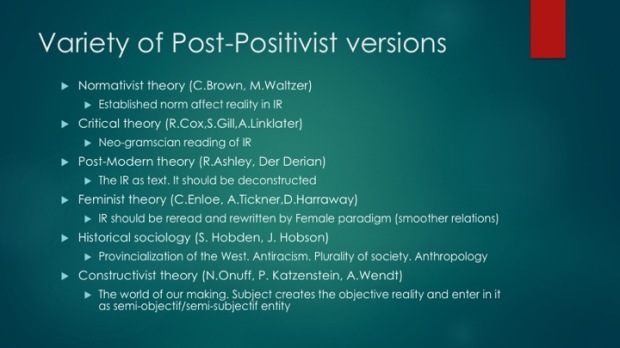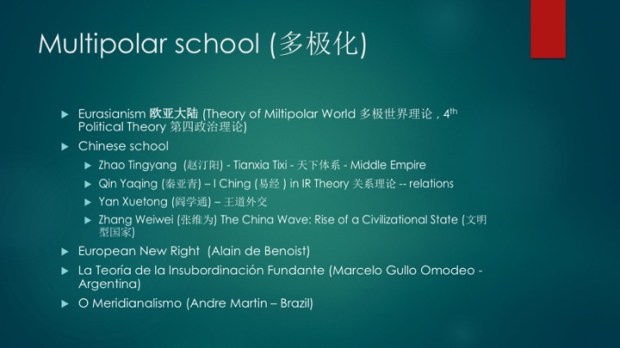Author: Alexander Dugin
Translators: Jafe Arnold and John Stachelski
Chapter 7 of Mysteries of Eurasia (Moscow: Arktogeia, 1991) / Chapter 6/Part 6/Book I of Foundations of Geopolitics (Moscow, Arktogeia, 2000).
***
Geopolitics as an “Intermediary” Science
Geopolitical concepts have long been the most important factor in modern politics. These concepts are based on general principles which allow one to readily analyze the situation of any country and any individual region.
In the form in which it exists today, geopolitics is undoubtedly a worldly, “profane”, secularized science. However, among all other modern sciences, it is geopolitics which has preserved the greatest connection to Tradition and the traditional sciences. René Guénon said that modern chemistry is the product of the desacralization of the traditional science of alchemy, just as modern physics has its origins in magic. Exactly in the same way, one could say that that modern geopolitics is the product of the secularization and desacralization of another traditional science, that of sacred geography. Since geopolitics occupies a peculiar place among modern sciences and is often ranked as a “pseudo-science”, its profanation is not nearly as complete and irreversible as in the case of chemistry or physics. Geopolitics’ relation to sacred geography is rather distinctly visible in this sense. Therefore, we can say that geopolitics occupies an intermediary place between traditional science (sacred geography) and profane science.
Land and Sea
The two essential concepts of geopolitics are Land and Sea. It is these two elements – Land and Water – that lie at the root of humans’ qualitative imagination of earthly space. In experiencing land and sea, earth and water, man enters into contact with the fundamental aspects of his existence. Land is stability, gravity, fixity, space as such. Water is mobility, softness, dynamism and time.
These two elements are, in their essence, the most obvious manifestations of the material nature of the world. They stand outside of man: everything is heavy and fluid. They are also inside him: in the body and blood. The same is the case at the cellular level.
The universality of the experiences of earth and water yields the traditional concept of the Firmament, since the presence of the Higher Waters (the source of rain) in the sky also implies the presence of a symmetric and necessary element – earth, land, the celestial vault. All together, Earth, Sea and Ocean are in essence the major categories of earthly existence, and it is impossible for mankind not to see in them some of the foundational attributes of the universe. As the two basic terms of geopolitics, they preserve their significance for both civilizations of a traditional kind and for exclusively modern states, peoples and ideological blocs. At the level of global geopolitical phenomena, Land and Sea generate the terms Thalassocracy and Tellurocracy, i.e., “power by means of sea” and “ power by means of land” – Sea Power and Land Power.
The strength of any state or empire is based upon the preferential development of one of these categories. Empires are either thalassocratic, or tellurocratic. The former implies the existence of a mother country and colonies, the latter a capital and provinces on “common land.” In the case of thalassocracy, its territory is not unified into one land space, which creates an element of discontinuity. The sea is both the strength and weakness of thalassocratic power. Tellurocracy, on the contrary, boasts the quality of territorial continuity.
Geographical and cosmological logic at once complicate this seemingly simple model of division: the pair of “land-sea”, by reciprocal superimposition of its elements, gives birth to the ideas of “maritime land” and of “land-water”. The maritime-land is an island, i.e., the base of maritime empire, the pole of thalassocracy. “Land-water” or water within land means rivers, which predetermine the development of overland empires. On the river we find the city, the capital, the pole of tellurocracy. This symmetry is symbolic, economic and geographical all at once. It is important to note that the statuses of Island and Continent are defined not so much on the basis of physical magnitude as by the peculiarities of the consciousness typical of their populations. Thus, the geopolitics of the US is of an island nature despite the dimensions of North America, whereas the island of Japan geopolitically represents the continental mentality, etc.
One more detail is relevant: historically, thalassocracy is linked to the West and the Atlantic Ocean, whereas tellurocracy is associated with the East and the Eurasian continent. The above-mentioned example of Japan is explained, thus, by the stronger “attractive” effect of Eurasia.
Thalassocracy and Atlanticism became synonyms long before the colonial expansion of Great Britain or Portuguese and Spanish conquests. Long before the first sea migration waves, the peoples of the West and their cultures had already begun their shift to the East from their centers located in the Atlantic. The Mediterranean was also mastered from the Gibraltar to the Middle East, and not the other way around. Meanwhile, excavations in Eastern Siberia and Mongolia demonstrate that ancient pockets of civilization once existed there, which means that none other than the central lands of the continent were the cradle of Eurasian mankind.
The Symbolism of Landscape
Besides these two global categories of Land and Sea, geopolitics also operates with more particular definitions. Maritime and oceanic formations can be differentiated among thalassocratic realities. For instance, the maritime civilizations of the Black Sea or Mediterranean Sea are rather qualitatively different from the civilizations of the oceans, i.e., insular powers and peoples dwelling on the shores of the open ocean. More particular divisions also exist between river and lake civilizations with relation to continents.
Tellurocracy also has its own particular forms. One can distinguish between the civilization of the Steppe and civilization of the Forest, the civilization of the Mountains and the civilization of the Plains, the civilization of the Desert and the civilization of Ice. In sacred geography, diverse varieties of landscapes are understood as symbolic complexes linked to the particularities of the state, religious and ethical ideologies of different peoples. Even in those cases where we are dealing with a universalist, ecumenical religion, the concrete embodiment of such in a given people, race or state will be subject to adaptation to the local sacred-geographical context. Deserts and steppes represent the geopolitical microcosm of the nomads, and it is precisely in the deserts and on the steppes that the tellurocratic tendency reaches its climax, as the “water” factor is minimally present. Desert and Steppe empires should therefore logically be the geopolitical springboards of tellurocracy. As an example of a Steppe empire, one might consider the Empire of Genghis Khan. A typical example of a Desert empire was the Arab Caliphate, which arose under the direct influence of nomads.
Mountains and mountain civilizations are more often than not archaic and fragmentary. Mountain countries are generally not sources of expansion, in fact, they tend to gather the victims of other tellurocratic forces’ geopolitical expansion. No empire has its center in a mountainous region. Hence the often repeated maxim of sacred geography, “mountains are inhabited by demons.” On the other hand, the idea that mountains can conserve the residual traces of ancient races and civilizations is reflected by the fact that it is precisely in mountains that the sacred centers of Tradition are placed. One could even say that mountains correspond to some kind of spiritual power in tellurocracy.
The logical combination of both concepts – the mountain as a hieratic model and the desert as a regal one – yields the symbolism of the hill, i.e., a small or average height. The hill is a symbol of imperial might rising above the secular level of the steppe, but it does not reach the limit of supreme power as is the case with mountains. A hill is a dwelling place for a king, a count, an emperor, but not a priest. All large tellurocratic empires’ capitals are placed on a hill or hills (often on seven hills – the number of the planets; or on five – the number of elements, including the ether, and so on).
The forest in sacred geography is similar to the mountains in a definite sense. The symbolism of the tree corresponds to the symbolism of the mountain (both the former and the latter designate the world axis). Therefore, in tellurocracies the forest also plays a peripheral function, as it too is the “place of the priests” (the druids, the magi, the hermits), but also at the same time the “place of demons”, i.e., archaic residuals from a vanished past. Thus, a forest cannot serve as the center of an overland empire.
The tundra represents the Northern analogue to the steppe and the desert, although the cold climate makes it much less significant from a geopolitical point of view. This “peripherality” reaches its apogee with the icebergs which, similarly to mountains, are deeply archaic zones. It is telling that the Eskimo shamanic tradition calls for a future shaman to depart alone on the ice, from where the world beyond will be opened to him. Thus, ice is a hieratic zone, the threshold of another world.
Taking into account these essential and most general characteristics of the geopolitical map, it is possible to define the various regions of the planet according to their sacred qualities. This method can also be applied to the local features of a landscape at the level of individual countries or even of individual localities. It is also possible to trace the convergence of the ideologies and traditions of what are seemingly very diverse peoples.
East and West in Sacred Geography
In the context of sacred geography, cardinal directions possess a special, qualitative nature. Visions of sacred geography can vary across traditions and periods in accordance with the cyclical phases of a given tradition’s development. Hence why the symbolic functions of cardinal directions often vary. Without diving into the details, it is possible to formulate the most universal law of sacred geography with regards to East and West.
Sacred geography, on the basis of “cosmic symbolism”, traditionally considers the East to be the “land of the Spirit”, the paradisal land, the land of perfection, abundance, the sacred “homeland” in its fullest and most complete form. In particular, this idea is mirrored in the Bible, where Eden has an Eastern position. The exact same understanding is characteristic of other Abrahamic traditions (Islam and Judaism), as well as many non-Abrahamic traditions, such as the Chinese, Hindu and Iranian traditions. “The East is the mansion of the gods”, states the sacred formula of the Ancient Egyptians, and the very word “East”, or neter in Egyptian, simultaneously meant “god.” From the point of view of natural symbolism, the East is the place where the sun, the Light of the World, the material symbol of Divinity and the Spirit, ascends, or vostekaet in Russian, hence the Russian word for “East”, vostok.
The West has the opposite symbolical meaning. It is the “land of death”, the “lifeless world”, the “green country” (as the Ancient Egyptians called it). The West is “the empire of exile” and “the pit of the rejected” in the expressions of Islamic mystics. The West is the “anti-East”, the country of the setting of the sun (zakat in Russian), decay, degradation, and transition from the manifest to the non-manifest, from life to death, from wholeness to need, and so on. The West [zapad in Russian] is the place where the sun descends, where it “sinks down” (zapadaet).
It is in accordance with this logic of natural cosmic symbolism that ancient traditions organized their “sacred space”, founded their cult centers, burial places, temples and edifices, and interpreted the natural and “civilizational” features of the planet’s geographical, cultural and political territories. Thus, the very structure of migrations, wars, campaigns, demographic waves, empire-building, etc. was defined by the primordial, pragmatic logic of sacred geography.
Peoples and civilizations possessing hierarchical characters stretched along the East-West axis – the closer to the East, the closer they were to the Sacred, to Tradition, to spiritual abundance. The closer to the West, the more the Spirit decayed, degraded and died.
Of course, this logic was not always absolute, but at the same time it was neither minor nor relative as it has so wrongly been considered by many “profane” scholars of ancient religions and traditions today. As a matter of fact, sacred logic and the tracing of cosmic symbolism were much more consciously recognized, understood and practiced by ancient peoples than is acceptably believed today. Even in our anti-sacred world, the archetypes of sacred geography are almost always retained in their integrity on the level of the “unconscious”, and are awoken at the most important and critical moments of social cataclysms.
Thus, sacred geography univocally affirms the law of “qualitative space”, in which the East represents the symbolic “ontological plus”, and the West the “ontological minus.” According to the Chinese tradition, the East is Yang, or the male, bright, solar principle, and the West is Yin, the female, dark, lunar principle.
East and West in Modern Geopolitics
Now we shall see how this sacred-geographical logic is mirrored in geopolitics, which, in the capacity of the exclusively modern science, merely fixates on the factual arrangement of affairs, leaving sacred principles themselves out of its framework and out of the picture.
Geopolitics in its original formulation by Ratzel, Kjellén, and Mackinder (and later by Haushofer and the Russian Eurasianists) took as its point of departure the peculiarities of different types of civilizations and states in relation to their dependence on geographical disposition. Geopoliticians established the fact that there is a fundamental difference between “insular” and “continental” powers, between “Western”, “progressive” civilization and “Eastern”, “despotic” and “archaic” cultural forms. Insofar as the question of the Spirit in its metaphysical and sacred understanding is generally never raised in modern science, geopoliticians have also brushed it aside, preferring to evaluate situations in different, more modern terms than those of the “sacred”, “profane”, “traditional”, “anti-traditional”, etc.
Geopoliticians have identified major differences between the political, cultural and industrial development of Eastern regions and Western ones over the past few centuries. The picture thereby derived is the following: the West is the center of “material” and “technological” development. On the cultural-ideological level, “liberal-democratic” tendencies and individualistic and humanistic worldviews prevail in the West. On the economic level, priority is assigned to trade and technological modernization. The theories of “progress”, “evolution”, and the “progressive development of history”, which are completely alien to the traditional Eastern world (and also to Western history in those periods when a rigorous sacred tradition was still in place there, as was the case in the Middle Ages), appeared for the first time in the West. On the social level, coercion in the West acquired only an economic character, and the Law of Idea and Force was gradually replaced by the Law of Money. A peculiar “Western ideology” was gradually cast in the universal formula of the “ideology of human rights”, which became the dominant principle in the most Western regions of the planet – North America, first and foremost the United States of America. On the industrial level, this ideology has corresponded with the notion of “developed countries”, and on the economic level is related to the concepts of the “free market” and “economic liberalism.”
The whole aggregate of these features, along with the purely military, strategic integration of different sectors of Western civilization, is defined today by the concept of “Atlanticism.” In the previous century, geopoliticians spoke of “Anglo-Saxon civilization” or “capitalist, bourgeois democracy”, but the “geopolitical West” has since found its most pure embodiment in the “Atlanticist” form.
The geopolitical East represents the direct opposite of the geopolitical West. Instead of economic modernization, here (in the “less developed countries”) traditional, archaic modes of production of the corporative or shop-manufacturing type prevail. Instead of economic coercion, the state more often employs “moral” or simply physical coercion (the Law of Idea and Law of Force). Instead of “democracy” and “human rights”, the East gravitates around totalitarianism, socialism and authoritarianism, i.e., around various types of social regimes whose only common feature is that the center of their systems is not the “individual” or “man” with his “rights” and his peculiar “individual values”, but something supra-individual, supra-human, be it “society”, “the nation”, “the people”, “the idea”, “the Weltanschauung”, “religion”, “the cult of the leader” etc. The East contradicts Western liberal democracy with a diversity of types of non-liberal, non-individualistic societies ranging from authoritarian monarchies to theocracies or socialism. Moreover, from a pure typological, geopolitical point of view, the political specificity of this or that regime is secondary in comparison to the qualitative division between “Western order” (= “individualist, mercantile”) and “Eastern order” (= “supra-individual – based on force”). The USSR, communist China, Japan until 1945 and Khomeini’s Iran have been representative forms of such an anti-Western civilization.
It is curious to note that Rudolf Kjellén, the first author to coin the term “geopolitics”, illustrated the differences between West and East in the following example:
“A typical pet phrase of the ordinary American,” Kjellén writes, “is ‘go ahead’, which literally means ‘go forward.’ In this is reflected the internal and intrinsic geopolitical optimism and ‘progressivism’ of American civilization, which is the extreme form of the Western model. The Russians, on the other hand, habitually repeat the word nichego [‘nothing’]. This manifests the ‘pessimism’, ‘contemplation’, ‘fatalism’, and ‘adherence to tradition’ peculiar to the East.”
If we now return to the paradigm of sacred geography, we see a direct antagonism between the priorities of modern geopolitics (such concepts as “progress”, “liberalism”, “human rights”, and “trade order” etc., are today positive terms for the majority of people), and the priorities of sacred geography, which evaluates different civilizational types from a completely opposite point of view (from the standpoint of such concepts as “spirit”, “contemplation”, “submission to superhuman force or superhuman idea”, “ideocracy”, etc., which in sacred civilizations are exclusively positive, and remain such to this day for the Eastern peoples on the level of the “collective unconscious”). Modern geopolitics (with the exceptions of the Russian Eurasianists, the German followers of Haushofer, Islamic fundamentalists etc.) analyzes and imagines the world from an opposite perspective than that of traditional sacred geography. But in this, both sciences still converge in their description of the fundamental laws of the geographical picture of civilizations.
Sacred North and Sacred South
In addition to the sacred-geographical determinism along the East-West axis, an extremely relevant problem is posed by another, vertical orientation or axis – that of North-South. Here, as in all other cases, the principles of sacred geography, the symbolism of cardinal points, and the continents related to each, have a direct analogue in the geopolitical picture of the world, which is either naturally built up over the course of the historical process, or is consciously and artificially formed as a result of the purposeful actions of the leaders of this or that geopolitical formation. From the point of view of the Integral Tradition, the difference between “artificial” and “natural” is generally rather relative, since Tradition never knew anything in the likes of the Cartesian or Kantian dualisms which strictly separate the “subjective” and the “objective” (or the “phenomenal” and “noumenal”). Therefore the sacred determinism of North or South is not only a physical, natural, or terranean-climatic factor (i.e., something “objective”), nor is it merely an “idea” or “concept” generated by the minds of individuals (i.e., something “subjective”). Rather, it is some kind of third form that is superior to both the objective and subjective poles. One might say that the sacred North, or the archetype of the North, was over the course of history split into the natural Northern landscape on the one hand, and the idea of the North, or “Nordicism”, on the other.
The most ancient and primordial layer of Tradition unequivocally affirms the primacy of North over South. The symbolism of the North corresponds to the Source, to the original Northern paradise from which all human civilization originates. Ancient Iranian and Zoroastrian texts speak of the northern country of Airyana Vaeja with its capital of Vara, from which the ancient Aryans were expelled by glaciation sent upon them by Ahriman, the spirit of Evil and opponent of the bright Ormuzd. The ancient Vedas also speak of a Northern land as the ancestral home of the Hindus, the Śveta-dvīpa, the White Land lying in the Far North. The Ancient Greeks spoke of Hyperborea, the Northern island with the capital Thule. This land was considered to be the homeland of the bright god Apollo. In many other traditions, one can detect the most ancient traces, so often forgotten and fragmentary, of this “Nordic” symbolism.
The fundamental idea traditionally associated with the North is the idea of the Center, the Immobile Pole, the point of Eternity around which revolves not only the cycle of space, but also the cycle of time. The North is the land where the sun never sets even at night, it is the space of eternal light. Every sacred tradition honors the Center, the Middle, the point where contrasts converge, the symbolic place that is not subject to the laws of cosmic entropy. This Center, whose symbol is the Swastika (which stresses both the immobility and constancy of the Center, and the mobility and changeability of the periphery), has acquired different names for each tradition, but it has always been directly or indirectly linked to the symbolism of North. Therefore, we can say that all sacred traditions are, in essence, the projection of the One Northern Primordial Tradition adapted to all different historical conditions. The North is the Cardinal Point chosen by the primeval Logos in order to reveal itself in History, and each of its further manifestations has only re-created this primordial polar-paradisal symbolism.
In sacred geography, the North corresponds to the spirit, light, purity, completeness, unity, and eternity. The South symbolizes something directly opposite – materiality, darkness, mixture, privation, plurality and immersion in the stream of time and becoming. Even from a natural point of view, in polar areas there is one long semi-annual Day and one long semi-annual Night. This is the Day and Night of the gods and heroes, of the angels. Even decayed traditions remember this sacred, spiritual, supernatural Cardinal North, recalling the Northern regions to be the dwelling place of “spirits” and “forces from beyond.” In the South, the Day and Night of the gods are fragmented into human days – here the primordial symbolism of Hyperborea has been lost, and its memories became mere pieces of “culture” or “legend.” The South generally often corresponds to culture, i.e., to that sphere of human activity at which the Invisible and the Purely Spiritual acquire material, hardened, visible outlines. The South is the reign of substance, life, biology and instincts. The South corrupts the Northern purity of Tradition, but preserves its traces in materialized features.
The North-South pair in sacred geography is not reduced to an abstract opposition of Good and Evil. It is rather the opposition of the Spiritual Idea to its coarsened, material embodying. In normal cases, in which the South recognizes the primacy of the North, there exist harmonious relations between these “parties of light”; the North “spiritualizes the South”, the Nordic messengers bring Tradition to the Southerners and lay the foundations of sacred civilizations. If the South fails to recognize the primacy of the North, then thus begins the sacred confrontation, the “war of continents.” In the view of Tradition, the South is responsible for this conflict in breaking sacred rules. In the Ramayana, for instance, the Southern island of Lanka is considered the dwelling place of demons that have stolen Rama’s wife, Sita, and declared war on the continental North with its capital of Ayodhya.
Thus, it is important to note that in sacred geography, the North-South axis is more important than the East-West axis. But being the more important one, it corresponds to the most ancient stages of cyclical history. The great war of North and South, of Hyperborea and Gondwana (the ancient paleo-continent of the South) belongs to “antediluvian” times. In the last phases of the cycle, it becomes more hidden, more veiled. The paleo-continents of North and South themselves disappear. Thus, the baton of opposition is passed to East and West.
The shift from the vertical North-South axis to the horizontal East-West axis typical of the last stages of the cycle nevertheless saves the logic and symbolic connection between these two sacred-geographical pairs. The North-South pair (i.e., Spirit-Matter, Eternity-Time) is projected on the East-West pair (i.e., Tradition and Profanity, Origin and Decay). The East is the downwards horizontal projection of the North. The West is the upwards horizontal projection of the South. Out of this transition of sacred meanings, one can readily obtain the structure of the continental vision peculiar to Tradition.
The People of the North
The Sacred North determines a special human type, which can have a biological, racial embodiment, but also might not have such a thing at all. The essence of “Nordicism” consists in the capacity of man to raise each object of the physical, material world to its archetype, to its Idea. This quality is not a simple development of a rational origin. On the contrary, the Cartesian and Kantian “pure intellect” is by its very nature incapable of overcoming the thin border between the “phenomenon” and “noumenon”, whereas it is precisely this ability that lies at the heart of “Nordic” thinking. The man of the North is not simply white, “Aryan” or Indo-European in terms of his blood, language, and culture. The man of the North is a particular kind of being endowed with a direct intuition of the Sacred. To him, the cosmos is a texture of symbols, each of them pointing towards the First Spiritual Principle that is invisible to the eye. The man of the North is the “solar man”, Sonnenmensch, who does not absorb energy, as black holes do, but allots it – the streams of creation, light, strength, and wisdom flow out of his spirit.
Pure Nordic civilization disappeared with the ancient Hyperboreans, but its messengers laid the foundations of all present traditions. This Nordic “race” of Teachers stood at the origins of the religions and cultures of the peoples of all continents and colors of skin. Traces of a Hyperborean cult can be found among the Indians of North America, among the Ancient Slavs, among the founders of the Chinese civilization, and among the natives of the Pacific, among the blonde Germans and black shamans of Western Africa, among the red-skinned Aztecs and among the Mongols with their wide cheek-bones. There is no people on the planet that does not have a myth about the “solar man”, Sonnenmensch. True spirituality, the supra-rational Mind, the divine Logos, and the capacity to see through the world to its secret Soul – these are the defining qualities of the North. Wherever there is Sacred Purity and Wisdom, there, invisibly, is the North – no matter what point in space or time we inhabit.
The People of the South
The man of the South, the Gondwana type, is directly opposite of the Nordic type. The man of the South lives in a circle of effects, of secondary manifestations; he dwells in the cosmos, which he venerates but does not understand. He worships exteriority, but not interiority. He carefully preserves traces of spirituality, their embodiments in the material environment, but he is not able to proceed from “symbolizing” to “the symbolized.” The man of the South lives by passion and speed, he puts the psychic above the spiritual (which he simply does not know) and worships Life as a higher authority. The cult of the Great Mother, of matter generating the variety of forms, is typical of the man of the South. The civilization of the South is a civilization of the Moon, which only receives light from the Sun (North), and preserves and diffuses it for some time only to periodically lose contact with it (the new moon). The man of the South is a Mondmensch.
When the people of the South stay in harmony with the people of North, i.e. recognize their authority and their typological (not racial!) superiority, harmony reigns among civilizations. When they claim their supremacy because of their archetypical relation to reality, there arises a distorted cultural type, which can be globally defined by adoration of idols, fetishism or paganism (in the negative, pejorative sense of this term).
As is the case with the paleo-continents themselves, purely Northern and Southern types existed only in remote ancient times. The people of the North and the people of the South confronted one another only in the primordial epochs. Later, whole peoples from the North penetrated the Southern lands, sometimes founding bright expressions of Nordic civilization, such as ancient Iran and India. On the other hand, peoples from the South sometimes went far northward, bearing their cultural type, such as Finns, Eskimos, Chukchi etc. The original clearness of the sacred-geographical panorama gradually became muddy. But in spite of all of this, the typological dualism of the “people of North” and the “people of the South” has been preserved in all times and epochs, only not so much in the form of an external conflict between two miscellaneous civilizations, as an internal conflict within the framework of any given civilization.
The type of the North and the type of the South have since some moment in sacred history opposed each other at every turn, irrespective of concrete places on the planet.
North and South in East and West
The type of the people of North can be projected in the South, East and West. In the South, the Light of North generated great metaphysical civilizations such as the Indian, Iranian or Chinese, which in the situation of the “conservative” South for a long time preserved the Revelation, were entrusted with it. However, the simpleness and clearness of Northern symbolism turned here into complex and miscellaneous tangles of sacred doctrines, sacraments and rites. The further to the South, the feebler are the traces of the North. And among the inhabitants of the Pacific islands and Southern Africa, Nordic motives in mythology and sacraments are preserved only in extremely fragmentary, rudimentary and even distorted form.
In the East, the North manifests itself as classical traditional society founded on the univocal superiority of the supra-individual above the individual, where the “human” and the “rational” are retracted in view of the supra-human and supra-rational Principle. If the South gives civilization “stability”, then the East defines its sacrality and authenticity, the major guarantor of which is the Light of the North.
In the West, the North is manifest in heroic societies, where such a tendency peculiar to the West as fragmentation, individualization and rationalization surpassed itself, and the individual, becoming the Hero, grew out of the narrow framework of the “human, all too human” personality. The North in the West is personified by the symbolic figure of Heracles who, on the one hand, releases Prometheus (the purely Western, titanic, “humanist” tendency), and on the other, helps Zeus and the gods to defeat the rebellion of the giants (i.e. serves for the sake of sacred rules and spiritual Order).
The South, on the contrary, projects itself on all three orientations according to an opposite image. In the North, it gives the effect of “archaism” and cultural stagnation. Even the most Northern, “Nordic” traditions, when under the Southern influence of “Paleo-Asiatic”, “Finnish” or “Eskimo” elements, took on the traits of “idol-worshipping” and “fetishism” (this is characteristic, in particular, of the Germano-Scandinavian civilization in the “epoch of the Skalds”).
In the East, the forces of the South surface in despotic societies, where the normal and just Eastern indifference towards the individual turns into denial of the great Supra-human Subject. All forms of Eastern totalitarianism, both typological and racial, are linked to the South.
Finally, in the West, the South is manifested in the extremely rough, materialistic forms of individualism in which the atomic individual reaches the limit of anti-heroic degeneration, worshipping only the “golden calf” of comfort and egotistical hedonism. That this combination of two sacred-geopolitical tendencies yields the most negative type of civilization is obvious, since it overlaps two orientations which are already in themselves negative – South on the vertical line and West on the horizontal line.
From Continents to Meta-Continents
If, from the perspective of sacred geography, the symbolic North unambiguously corresponds to positive aspects, and the South to negative, then in the exclusively modern geopolitical picture of the world, everything is much more complex – and to some extent even upside down. Modern geopolitics understands the terms “North” and “South” as wholly different categories than sacred geography does.
First of all, the paleo-continent of the North, Hyperborea, has not existed for many millennia on a physical level, but remains a spiritual reality towards which the spiritual gaze of the initiated yearning for primordial Tradition has been directed .
Secondly, the ancient Nordic race, the race of the “white teachers” who descended from the pole in the primordial era, does not at all coincide with what is today commonly called “white race” based only on physical characteristics, skin color, etc. The Northern Tradition and its original population, the “Nordic autochthones”, have not existed for quite some time as a historical-geographical reality. Judging by things as they stand at present, even the last remnants of this primordial culture disappeared from physical reality some millennia ago.
Thus, ‘the North’, looked at in terms of Tradition, is a meta-historical and meta-geographical reality. The same can be said about the “Hyperborean race” – it is not a ‘race’ in the biological, but rather, in a purely spiritual, metaphysical sense. The topic of “metaphysical races” was developed in detail in Julius Evola’s work.
The continent of the South, ‘the South’ as it exists in Traditionalist terms, and its most ancient population have not existed for quite some time. In a certain sense, the “South” at a certain moment came to make up practically the entire planet, as the influence of the original polar initiatic center and its messengers dissipated across the entire world. The modern races of the South represent a product of multiple mixtures with the races of North, and skin color in general long ago ceased to be a distinctive sign of belonging to one or another “metaphysical race.”
In other words, the modern geopolitical picture of the world has very little in common with the fundamentally supra-historical and meta-temporal view of the world. The continents and populations of our epoch are extremely far removed from those archetypes to which they corresponded in primordial times. Therefore, today there exists not merely a discrepancy, but an almost inverse correspondence between actual continents and actual races (the realities of modern geopolitics) on the one hand, and meta-continents or meta-races (the realities of traditional sacred geography) on the other.
The Illusion of the “Rich North”
Modern geopolitics refers to the concept of the “North” most frequently alongside the adjective “rich” – the “rich North,” the “advanced North”. This term refers to an aggregate of Western civilization which attaches fundamental attention to the development of the material and economic side of life. The “rich North ” is rich not because it is more clever, more intellectual, or more spiritual than the “South”, but because it has built its social system on the principle of maximizing the material that can be extracted from social and natural potential, from the exploitation of humans and natural resources. The racial image of the “rich North” is linked to people with white skin, a feature which is central to various versions, whether explicit or implicit, of “Western racism” (in particular Anglo-Saxon racism). The success of the “rich North” in the material sphere was raised to a political and even “racial” principle in those countries which became the vanguard of industrial, technical and economic development, i.e., England, Holland, and later Germany and the US. In this case, material and quantitative welfare amounted to a qualitative criterion, and it is on this basis that the most ridiculous prejudices about the “barbarism”, “primitiveness”, “underdevelopment” and “untermenschlichkeit” of the Southern peoples (i.e., those not belonging to “rich North”) came about. Such “economic racism” was clearly manifested in Anglo-Saxon colonial conquest. Later, an embellished version was introduced in the most coarse and contradictory aspects of National-Socialist ideology. Nazi ideologists often blended vague guesses about pure “spiritual Nordism” and the “spiritual Aryan race” with the vulgar, mercantilistic, biological racism of the English variety. This substitution of sacred-geographical categories with categories of material and technical development was the most absolutely negative aspect of National-Socialism, and the element which led to its political, theoretical and military collapse. Yet, even after the defeat of the Third Reich, this kind of “rich North” racism has not disappeared from political life. Now, the US and its Atlanticist partners in Western Europe have become its primary bearers. In the most recent globalist doctrines of the “rich North”, questions of biological and racial purity are not stressed; nevertheless, in practice, the rich North’s relations with undeveloped and less developed countries of the Third World still advance the “racist” haughtiness typical of both English colonialists and the German National-Socialists’ orthodox Rosenberg line.
In fact, the “rich North”, in geopolitical terms, refers to those countries where forces directly opposed to Tradition have won out – the forces of quantity, materialism, atheism, spiritual degradation and emotional degeneration. The “rich North” is radically distinct from “spiritual Nordism” and the “Hyperborean spirit.” The substance of the North in sacred geography is the primacy of spirit over matter, the definitive and total victory of Light, Justice and Purity over the darkness of animal life, the arrogance of individual passions and the mud of base egoism. The globalist geopolitics of the “rich North”, on the contrary, means exclusively material welfare, hedonism, the consumer society, the “problem-free” and artificial pseudo-paradise of those whom Nietzsche called “the last men.” The material progress of technological civilization has been accompanied by the monstrous spiritual regress of all truly sacred culture. From the point of view of Tradition, the “wealth” of the modern, “advanced” North cannot serve as genuine criteria of any real superiority over the material “poverty” and technological backwardness of the modern “primitive South.”
Moreover, the material “poverty” of the South is quite often conversely linked tied to Southern regions’ conservation of genuinely sacred forms of civilization. Spiritual wealth is sometimes disguised behind ostensible “poverty.” At least two such sacred civilizations still exist in the Southern space today despite all the attempts by the “rich (and aggressive!) North” to impose its own measures and path of development on the whole world: Hindu India and the Islamic world. In terms of Far Eastern traditions, there are various points of view: some see certain traditional principles that have always been definitive for Chinese civilization, even beneath the “Marxist” and “Maoist” rhetoric. These Southern regions are inhabited by peoples who have maintained their devotion to very ancient, nearly forgotten sacred traditions. Compared to the atheist and utterly materialistic “rich North”, these peoples are “spiritual”, “whole” and “normal”, while the “rich North” itself is “abnormal” and “pathological” from a spiritual point of view.
The Paradox of the “Third World ”
In terms of globalist projects, the “poor South” is de facto a synonym for the “Third World.” This part of the world was referred to as the “third” during the Cold War, a notion which presupposed that the other two “worlds” – the advanced capitalist and less-advanced Soviet – were more relevant and significant to geopolitics than all other regions. The expression “Third World” has a pejorative connotation: according to the utilitarian logic of the ”rich North”, such a definition renders Third World countries tantamount to a “no man’s land”, to little more than human resource reservoirs slated for subservience, exploitation and manipulation. In so doing, the “rich North” has skillfully played on the traditional political-ideological and religious characteristics of the “poor South” by subjugating it to its exclusively materialist and economic interests and structures which are, in terms of spiritual potential, far superior to the “rich North” itself. The “rich North” has almost always succeeded in this subjugation, since the very cyclical moment of our civilization is conducive to perverted, abnormal and unnatural tendencies. This is due to the fact that, according to Tradition, we are now in the latest period of the dark age, the ‘Kali Yuga.’ Hinduism, Confucianism, Islam and the indigenous traditions of the “non-white” peoples are but an impediment to the material conquests and aims of the “rich North”; yet, at the same time, certain aspects of Tradition are often appropriated to achieve their mercantile goals by manipulating contradictions, religious peculiarities or national problems. Such utilitarian appropriations of various aspects of Tradition for exclusively anti-traditional aims have been an even greater evil than the outright denial of all Traditional values, since the highest perversion is for the great to be made subservient to the “nothing.”
In reality, the so-called “poor South ” is only “poor” on a material level precisely because of its spiritual attitudes, having always reserved only a minor and unimportant place for the material aspects of existence. The geopolitical South in our time has preserved a uniquely traditionalist attitude towards the objects of the external world, a calm, detached, and even indifferent attitude which starkly contrasts the obsessions of the “rich North” with materialist and hedonistic paranoia. The people of the “poor South”, by virtue of living in Tradition, to this day have fuller, more profound and even more magnificent existences. Participation in sacred Tradition bestows upon all aspects of their personal lives’ a meaning, an intensity and a saturation, of which the “rich North” has long been deprived. The latter is left hysterical with neuroses, material fears, inner desolation and a completely pointless existence. It is little more than a languid kaleidoscope with pictures as vivid as they are empty.
It could be said that the correlation between North and South in primordial times has a directly inverse correlation in our present epoch, as it is the South which today still preserves some links with Tradition, whereas the North has definitively lost them. Nevertheless, this statement does not cover the whole picture of reality, since true Tradition cannot abide such humiliating treatment as that practiced by the aggressively atheistic “rich North” against the “Third world.” The fact of the matter is that Tradition has been preserved in the South only in an inertial, fragmentary, partial form. It holds a passive position and can only resist, it is permanently on the defensive. Thus, the spiritual North has not fully transferred itself to the South in the End Times – the South only accumulates and preserves spiritual impulses that once came from the sacred North. No active traditional initiative can come from the South in principle. Meanwhile, the globalist “rich North” has managed to harden its pernicious grasp on the planet due to the specificity of the Northern regions that are conducive to activity. The North was and remains by its very nature the chosen place of power. Thus, truly effective geopolitical initiatives come from the North.
The “poor South” today has a spiritual advantage over the “rich North”, but it cannot serve as a serious alternative to the profane aggression of the “rich North”, nor can it offer the radical geopolitical project capable of subverting the pathological vision of the modern world.
The Role of the “ Second World”
In the bipolar geopolitical picture of “rich North” vs. “poor South”, there has always existed an additional component of self-sufficient and critical significance. This is the so-called “Second World”, which is conventionally understood to mean the socialist camp that was integrated into the Soviet system. This “Second World” was not quite the “rich North”, since it had definite spiritual motives that secretly influenced the nominally materialistic ideology of Soviet socialism, nor was it really the “Third world”, since overall an orientation towards material development, “progress” and other exclusively profane principles were at the heart of the Soviet system. The geopolitically Eurasian USSR was located both in “poor Asia” and “civilized” Europe. During the socialist period, the planetary belt of the “rich North” was broken in Eastern Eurasia, thus complicating the clarity of geopolitical relations on the North-South axis.
The end of the “Second World” as a special civilization left the former USSR’s Eurasian space with two alternatives: either integration into the “rich North” (that is, the West and the US), or being thrown down to the “poor South”, i.e., to turn into a “Third world country.” One possible compromise would be the separation of some of the regions to the “North” and some to the “South.” As has often been the case over the last few centuries, the initiative of redistributing geopolitical spaces was the prerogative of the “rich North”, which cynically used the paradoxes of the “second world” itself to fix new geopolitical borders and break up zones of influence.
National, economic and religious factors are regularly instrumentalized by the globalists as tools in their cynical and deeply materialist-motivated operations. It is therefore no surprise that, in addition to false “humanist” rhetoric, almost blatantly “racist” pretexts are now increasingly invoked to incite Russians to demonstrate a “white superiority complex” towards Asian and Caucasian Southerners. This correlates with the inverse process of the former “Second World” being driven finally towards the “poor South” which has been accompanied by manipulations of fundamentalist tendencies, of the peoples’ inclination towards Tradition and of the revival of religion.
The disintegrating “Second World” is being broken apart along the lines of “traditionalism” (the southern, inertial, conservative kind) and “anti-traditionalism” (the actively Northern, modernist and materialist kind). This dualism, which is only being strategized today but will become the predominant phenomenon in Eurasian geopolitics in the near future, is predetermined by the spread of the globalist understanding of the world in terms of “rich North” and the “poor South.” Any attempt to save the former Soviet Great Space, and any attempt to save the “Second World” as something self-sufficient and balancing halfway between North and South (in their exclusively modern meaning), cannot be successful without altogether questioning the fundamentally polar conception of modern geopolitics as understood and realized in its actual form, brushing aside deceitful humanitarian and economic proclamations.
The “Second World” is disappearing. There is no more place for it on the modern geopolitical map. At the same time, the pressure of the “rich North” on the “poor South” is increasing, with the latter left to fend against the aggressive materialistic technocratic society of the “North” in the absence of an intermediate power, such as the Second World was. Any other possible destiny for the “Second World” will only be possible if accompanied by a radical rejection of the planetary logic of the North-South dichotomy in its globalist vein.
The Project for the “Resurrection of the North”
The rich globalist North is spreading its domination across the planet through the partition and destruction of the “Second World.” In modern geopolitics, this has also been called the project of the “New World Order.” The active forces of anti-tradition are consolidating their victory over the passive recalcitrance of the Southern regions which continue to preserve their economic backwardness and defend their residual forms of Tradition. The inner geopolitical energies of the “Second World” face a choice – either be annexed into the “civilized Northern belt” and decisively lose any connection with sacred history (which is the project of leftist globalism), or become an occupied territory allowed to partially restore some aspects of tradition (the project of right-wing globalism). Events are developing in precisely this direction today and they will continue to in the near future.
As for an alternative, it is theoretically possible to formulate a different path for geopolitical transformation based on rejecting the North-South globalist logic and on returning to the spirit of genuine sacred geography – to the extent that such is possible now, at the end of the dark age. This is the project of the “Great Return” or, in other terms, the “Great War of Continents.” In its most general features, the essence of this project is as follows:
(1) The rich North will be opposed, not by the “poor South”, but by the “poor North.” The poor North is the sacred ideal of returning to the Nordic sources of civilization. Such a North is “poor” because it is based on total asceticism, on radical devotion to the highest values of Tradition, on utter hatred of the material for the sake of the spiritual. The “poor North” exists (in a geographical sense) in Russia, which, essentially being the “Second World”, has socio-politically resisted the adoption of globalist civilization in its most “progressive” forms to the present moment. The North Eurasian lands of Russia are the only territories on earth which have not been completely mastered by the “rich North.” They are inhabited by traditional peoples and are terra incognita in the modern world. The “path of the poor North” for Russia means refusing to be annexed by the globalist belt and refusing to have its traditions archaized, reduced to the folkloric level of an ethno-religious reservoir. The “poor North” must be spiritual, intellectual, active and aggressive. Potential opposition by the “poor North” to the “rich North” is possible in other regions as well, perhaps manifesting itself in part of the Western intellectual elite radically sabotaging the course of mercantile civilization and rebelling against the modern world of finance for the sake of the ancient, eternal values of the Spirit, Justice and Self-Sacrifice. The “poor North” could thus launch a geopolitical and ideological battle against the “rich North”, rejecting its projects, destroying its plans from the inside and out, combating its stainless efficiency and thwarting its social and political manipulations.
(2) The “poor South”, incapable of independently opposing the rich North, will enter a radical alliance with the poor Eurasian North and begin a liberation war against the Northern dictatorship. It is especially important to strike at representatives of the ideology of the “rich South ”, i.e., those forces which, working for the “rich North”, stand for the “development”, “progress” and “modernization” of traditional countries, which will otherwise lead to a further departure from what remains of sacred Tradition.
(3) The “poor North” of the Eurasian East, together with the “poor South”, will surround the entire planet, concentrating their forces against the “rich North” of the Atlanticist West. These efforts will put an end to the ideologically vulgar versions of Anglo-Saxon racism and praise of the “technological civilization of the white peoples” along with its accompaniment globalist propaganda. Alain de Benoist expressed this idea in the title of his famous book Europe, Tiers Monde – même combat [“Europe and the Third World: The Same Fight”], which argues for a “spiritual Europe”, a “Europe of peoples and traditions” instead of the “Maastricht Europe of commodities.” The intellectualism, activism and spiritual profile of the genuine, sacred North will return the South’s traditions to their Nordic Source, and raise the Southerners in a planetary uprising against the common geopolitical enemy. In so doing, the passive resistance of the South will form a beachhead in the planetary messianism of the “Nordicists” who radically reject the degenerated and anti-sacred branch of white peoples who have followed the path of technological progress and material development. This could spark a planetary, supra-racial and supra-national Geopolitical Revolution based on the fundamental solidarity of the “Third World” with that part of the “Second World” which rejects the project of the “rich North”.
Over the course of this struggle, the flame of the “resurrection of the spiritual North”, the flame of Hyperborea, will transform geopolitical reality. The new global ideology will be that of Final Restoration, putting a final end to the geopolitical history of civilizations – but this will not be the end which the globalist spokesmen of the End of History have theorized. The materialistic, atheistic, anti-sacred, technocratic, Atlanticist version of the End will give way to a different epilogue – the final Victory of the sacred Avatar, the coming of the Great Judgement, which will grant those who chose voluntary poverty the kingdom of spiritual abundance, while those who preferred wealth founded on the assassination of the Spirit will be condemned to eternal damnation and torment in hell.
Lost continents will arise out of the abysses of the past. Invisible meta-continents will appear in reality. A New Earth and a New Heaven will arise.
Thus, the path is not from sacred geography to geopolitics but, on the contrary, from geopolitics to sacred geography.







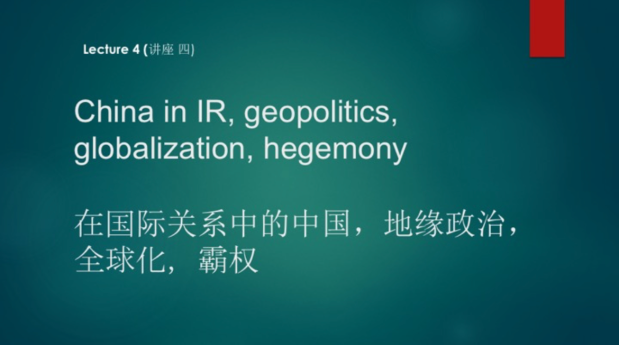

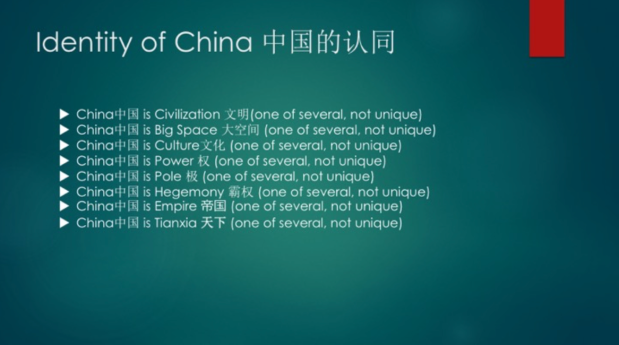
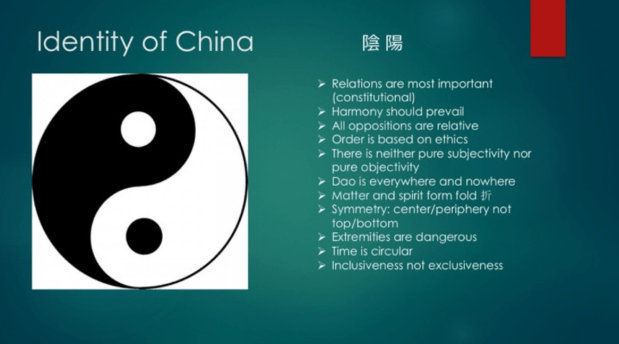

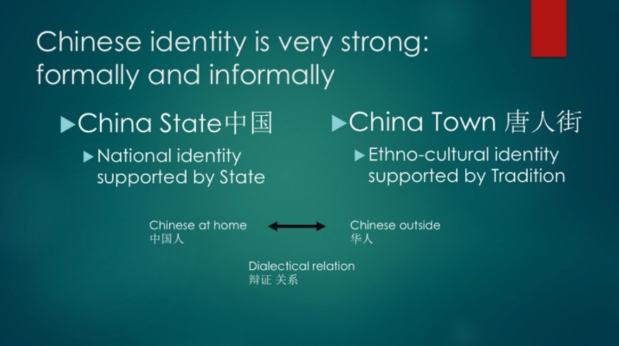

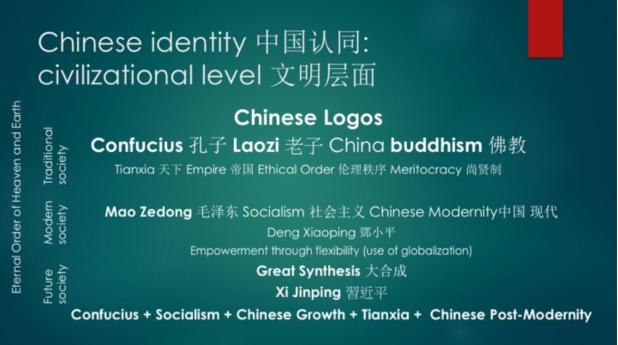 In modern society you have another form of the Chinese Logos: Mao Zedong, socialism, and Chinese modernity are a kind of new form of the Chinese Logos adapted to new challenges in your history. In your present situation, this is just as important as the heritage of traditional Chinese identity. These are new names for things. Confucius said that we need to improve the names of things. Mao Zedong has improved some names to adapt them to reality without destroying relations between things, while continuing the same Chinese identity. In this situation, Deng Xiaoping added to this vision some new features, such as opening to the West – but not in order to give up your identity, but with the flexibility to empower your identity, to stay Chinese in the new global world.
In modern society you have another form of the Chinese Logos: Mao Zedong, socialism, and Chinese modernity are a kind of new form of the Chinese Logos adapted to new challenges in your history. In your present situation, this is just as important as the heritage of traditional Chinese identity. These are new names for things. Confucius said that we need to improve the names of things. Mao Zedong has improved some names to adapt them to reality without destroying relations between things, while continuing the same Chinese identity. In this situation, Deng Xiaoping added to this vision some new features, such as opening to the West – but not in order to give up your identity, but with the flexibility to empower your identity, to stay Chinese in the new global world. 
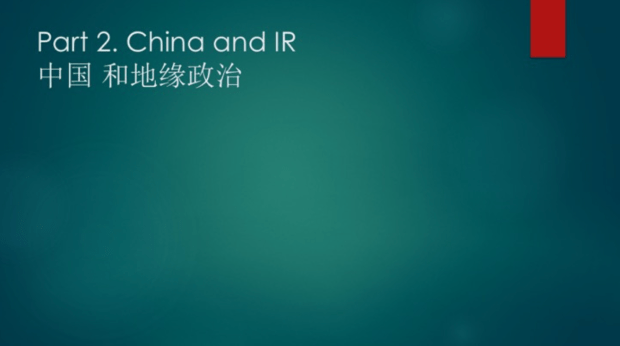 The next step is China in International Relations.
The next step is China in International Relations.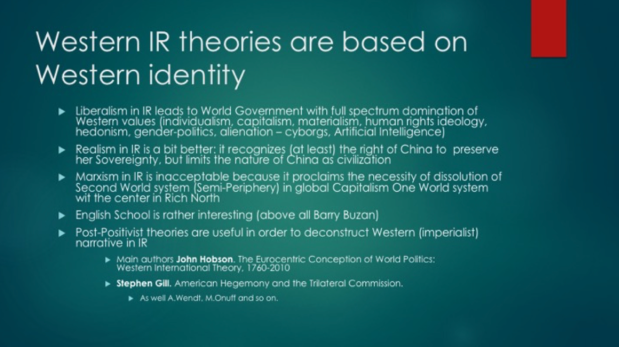
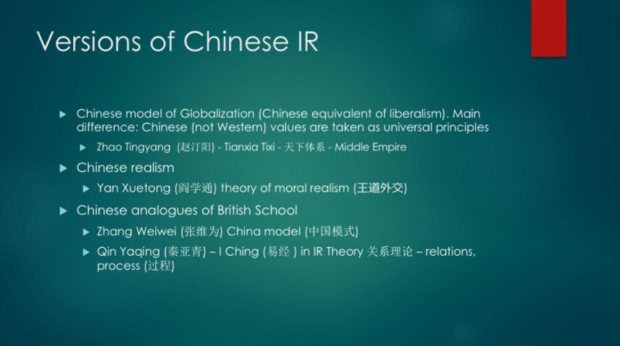
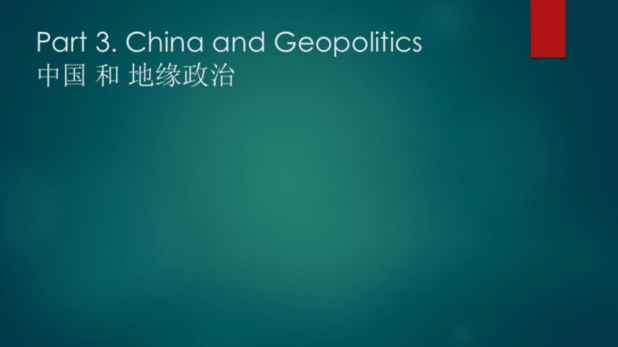
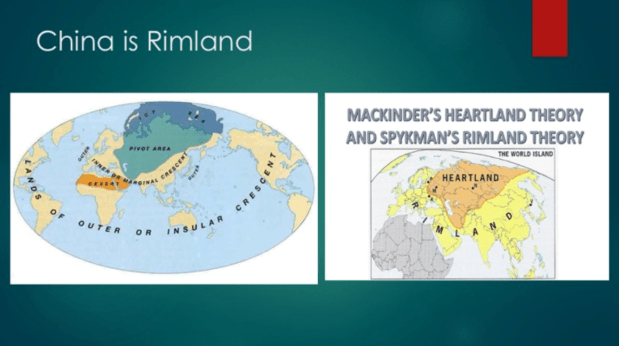
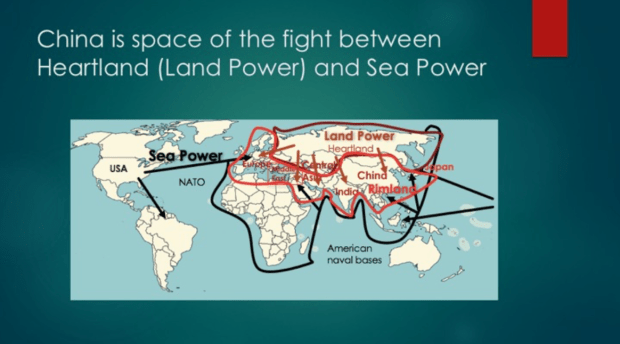
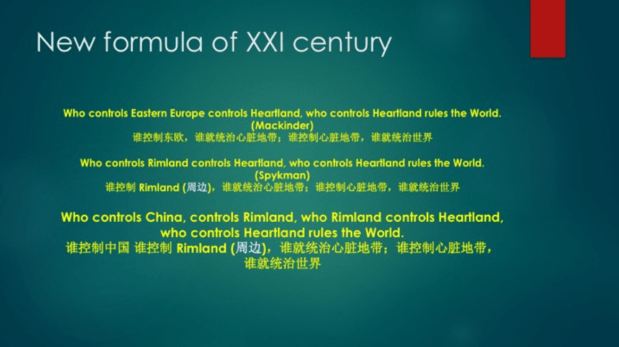
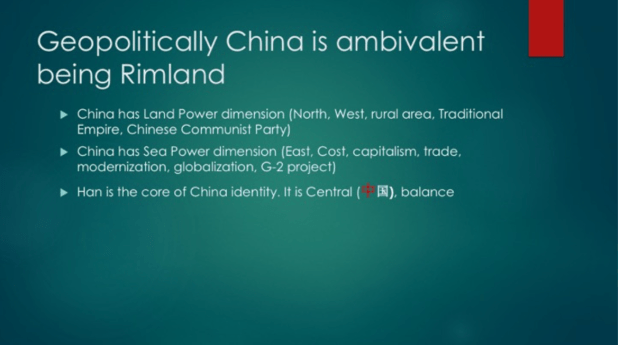

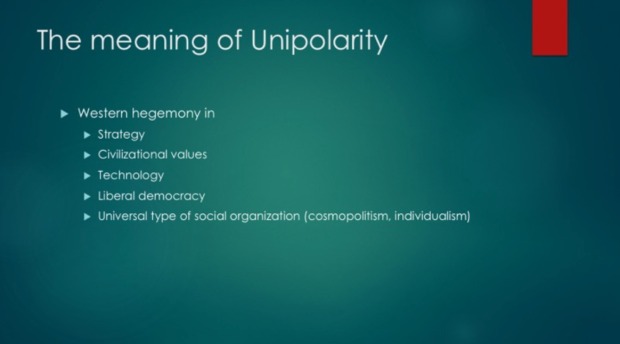
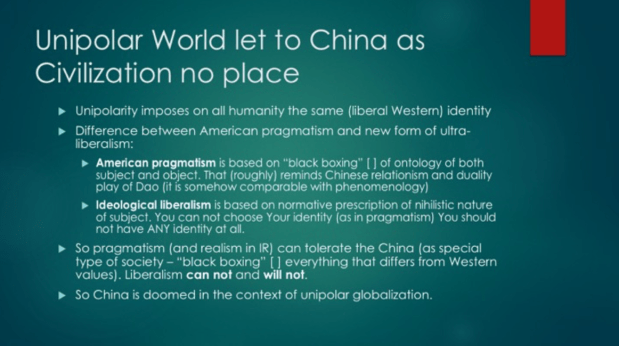

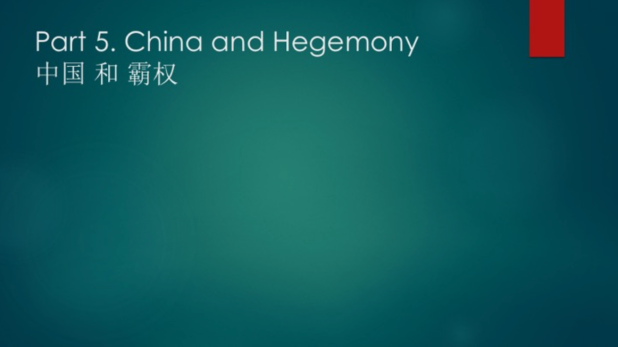
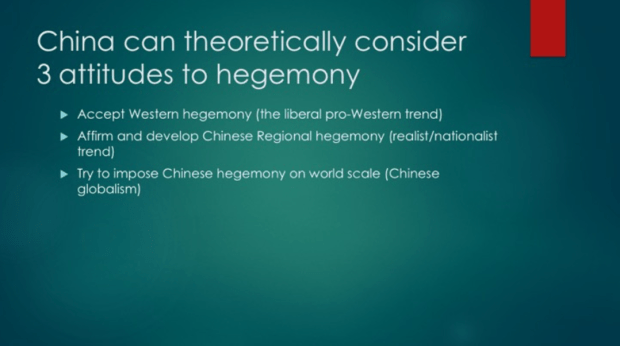
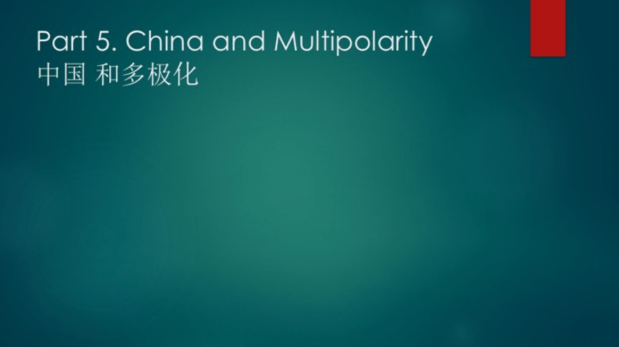



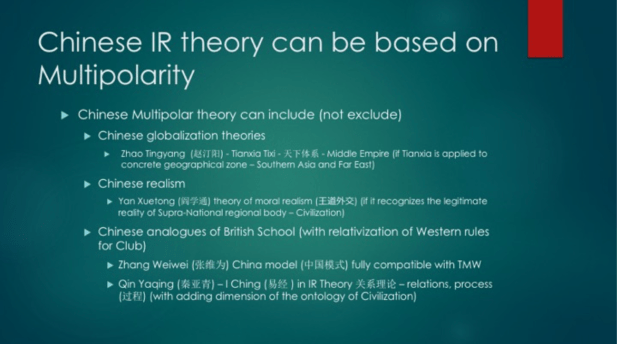
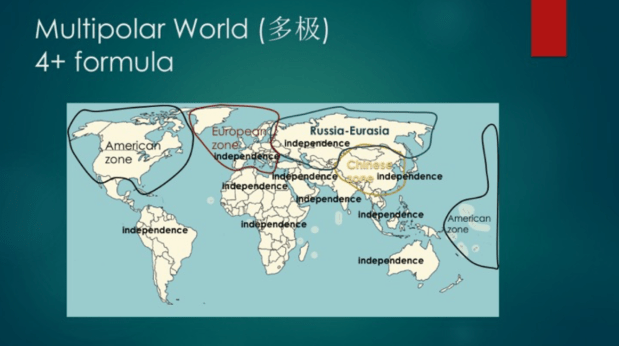
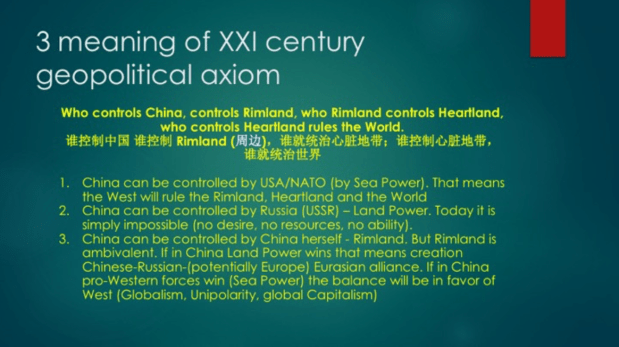

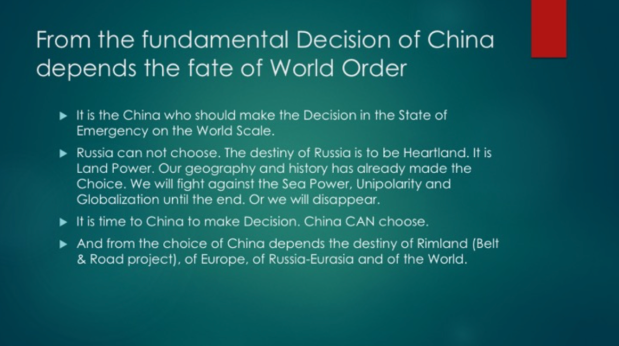


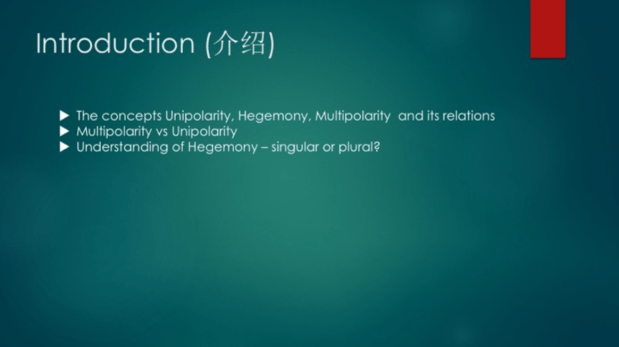
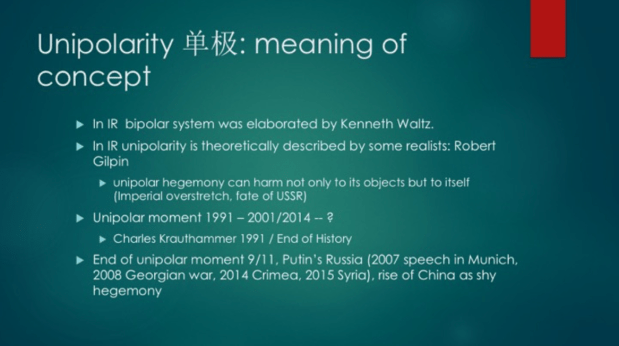
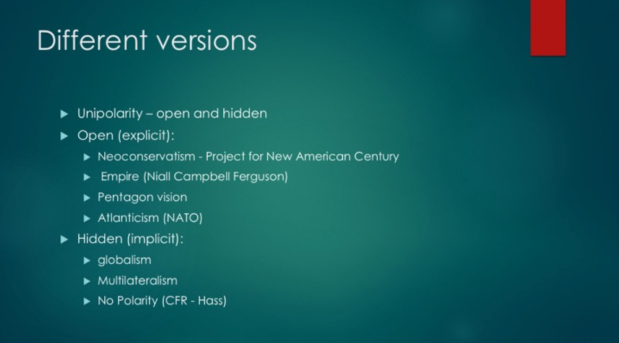 Unipolarity includes different aspects. For example, we could divide unipolarity into groups of concepts – open or “explicit”, and hidden, “secret”, or “implicit” unipolarity.
Unipolarity includes different aspects. For example, we could divide unipolarity into groups of concepts – open or “explicit”, and hidden, “secret”, or “implicit” unipolarity.  Strategic unipolarity includes Atlanticism, Sea Power in geopolitical terms, and full spectrum dominance doctrine, which affirms that in order to dominate the world totally, the West should not only use hard power or military power, but also soft power, culture, technology, network services, networks, and social services, that should control other societies from the inside, not only from the outside. That is the idea of full spectrum dominance – domination of the air, the cosmos, space, sea, land, and inside human brains. That is a project of controlling human behavior, psychology, being, and human minds, by coding them through different methodologies.
Strategic unipolarity includes Atlanticism, Sea Power in geopolitical terms, and full spectrum dominance doctrine, which affirms that in order to dominate the world totally, the West should not only use hard power or military power, but also soft power, culture, technology, network services, networks, and social services, that should control other societies from the inside, not only from the outside. That is the idea of full spectrum dominance – domination of the air, the cosmos, space, sea, land, and inside human brains. That is a project of controlling human behavior, psychology, being, and human minds, by coding them through different methodologies. 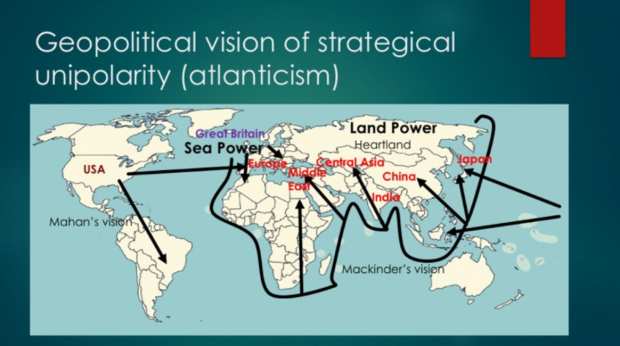
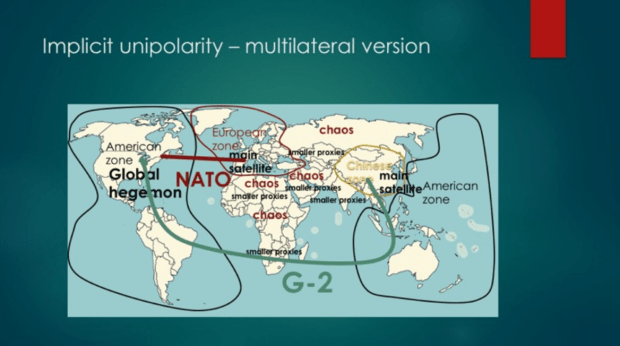



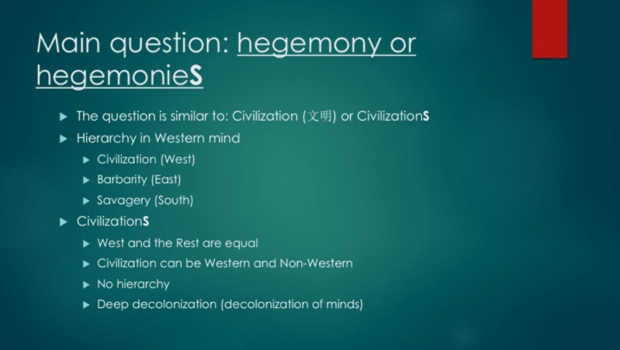
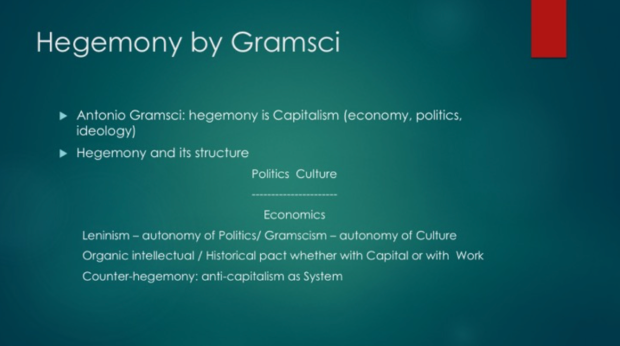
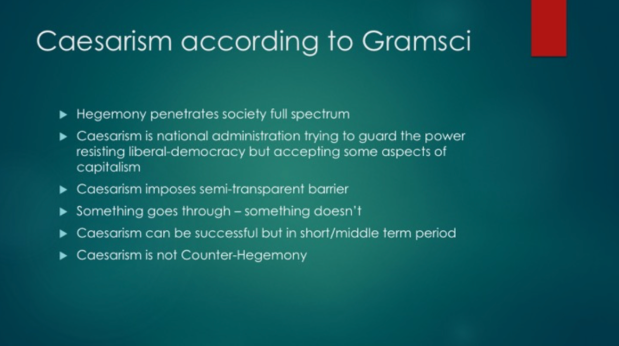
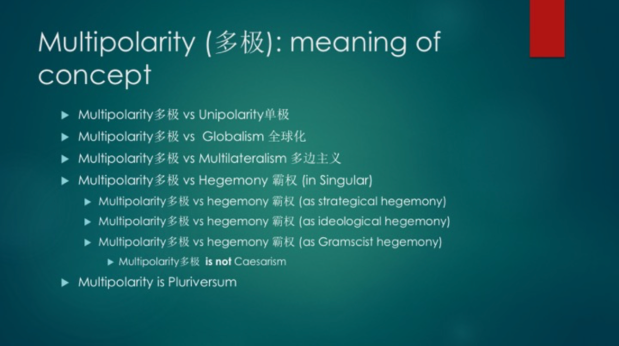
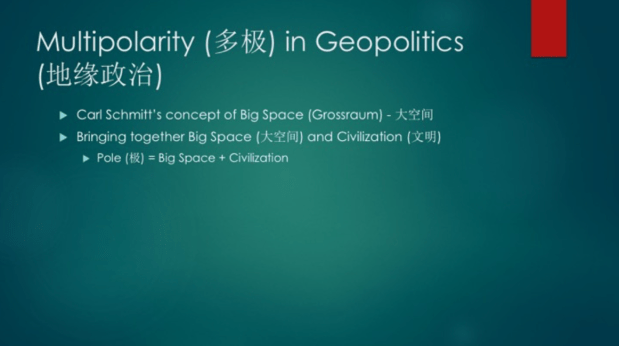
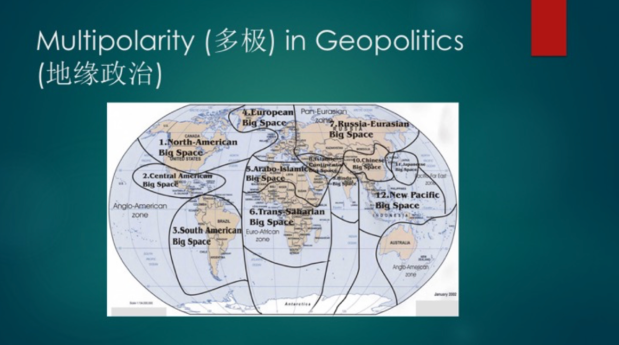
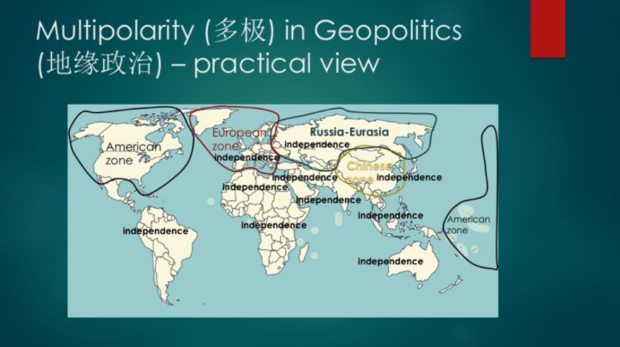
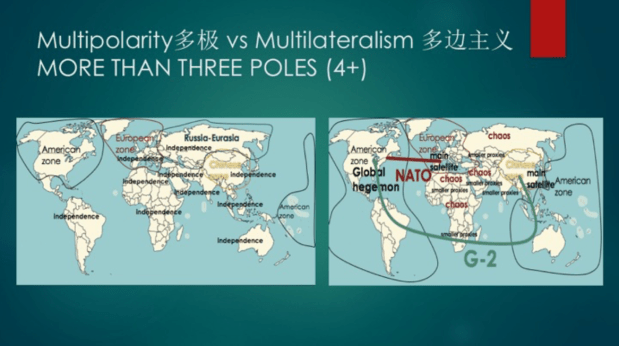
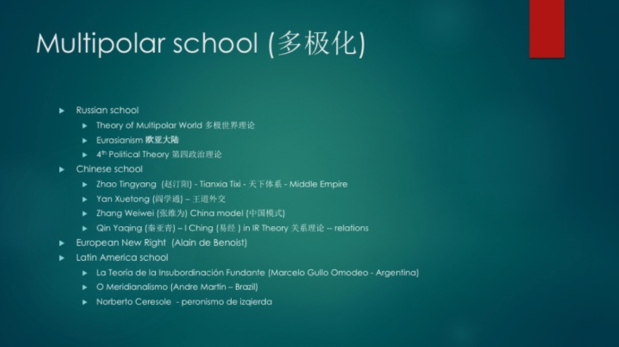 This state of things is more or less consciously understood by some academic groups in the world. We can call that the “multipolar world theory.” My own book in Russia, The Theory of the Multipolar World, which has been translated into French, is in the process of being published in English, and has been translated into Portuguese, Spanish, and other languages, presents this theory, and tries to put all of these elements that I have explained together.
This state of things is more or less consciously understood by some academic groups in the world. We can call that the “multipolar world theory.” My own book in Russia, The Theory of the Multipolar World, which has been translated into French, is in the process of being published in English, and has been translated into Portuguese, Spanish, and other languages, presents this theory, and tries to put all of these elements that I have explained together. 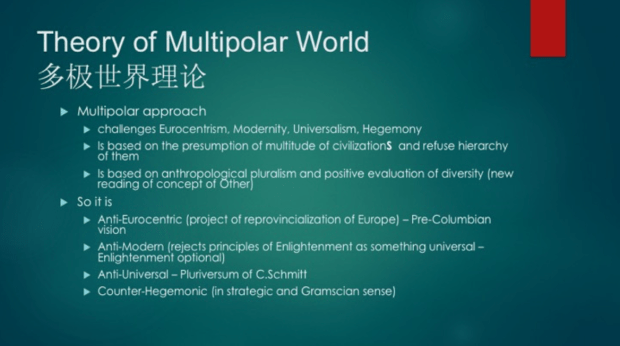
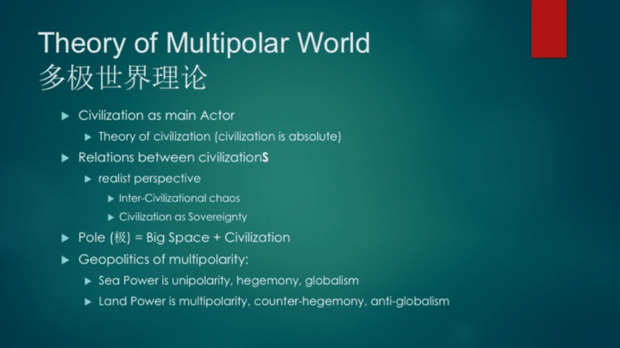
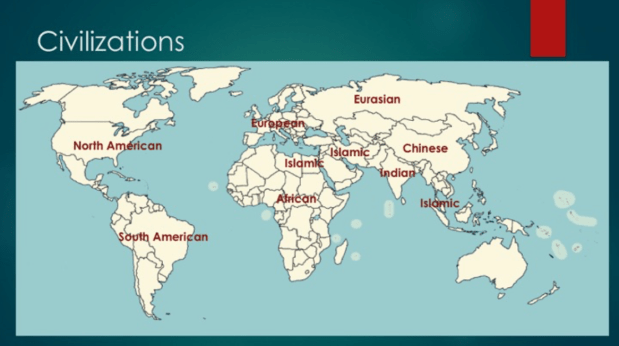 Here we can see civilizations corresponding more or less to Big Spaces and strategic analysis. Eurasianism and the Fourth Political Theory are a part of this.
Here we can see civilizations corresponding more or less to Big Spaces and strategic analysis. Eurasianism and the Fourth Political Theory are a part of this.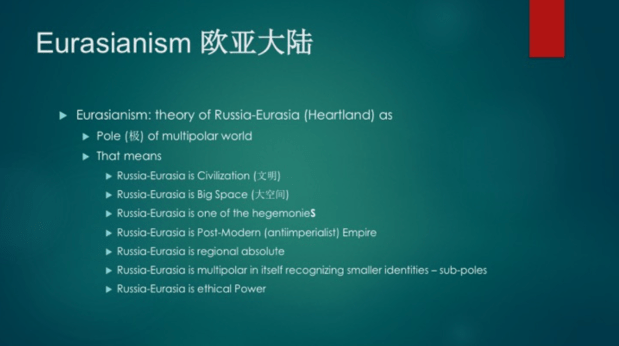
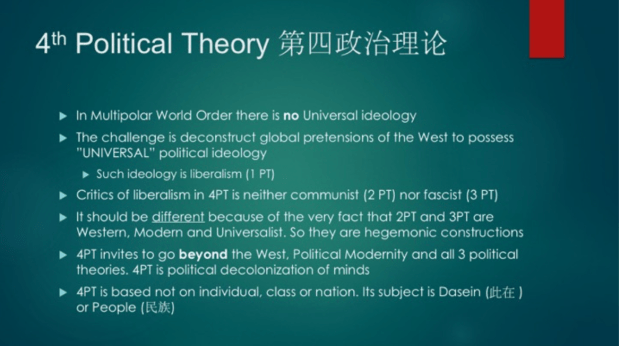

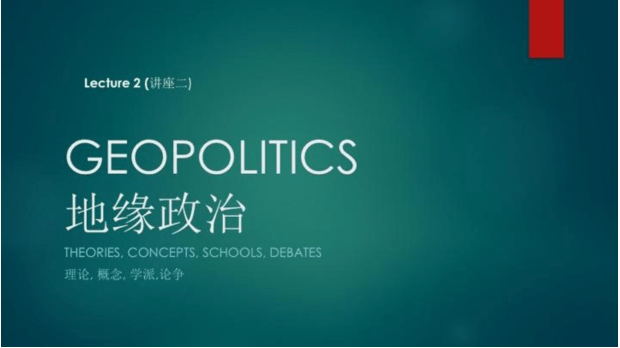
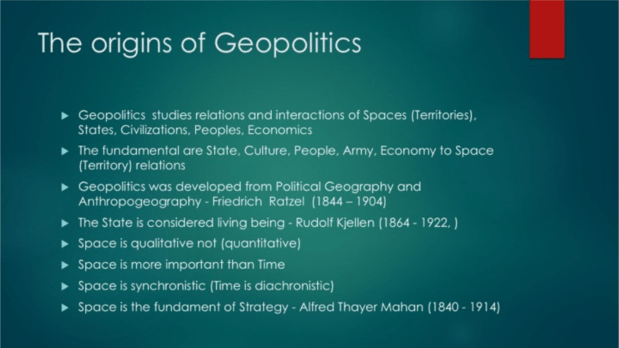

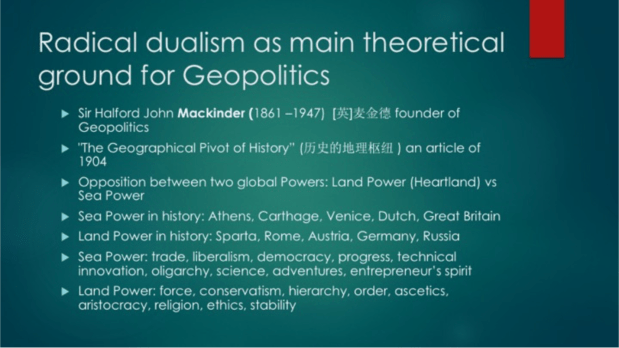
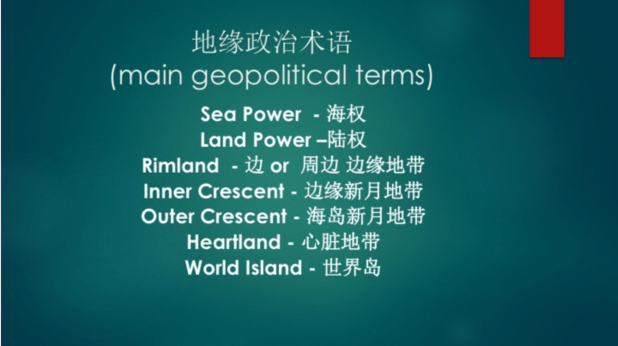
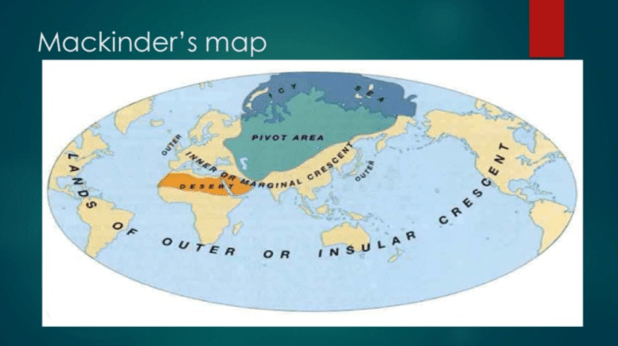
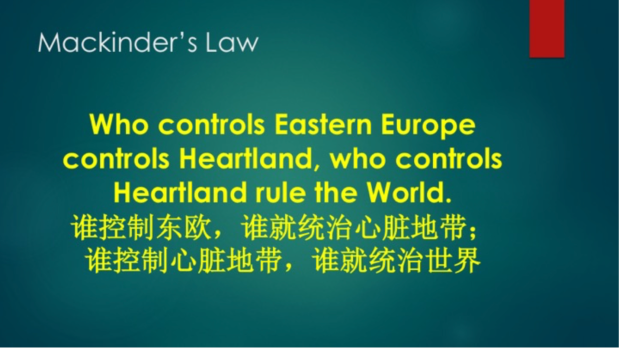
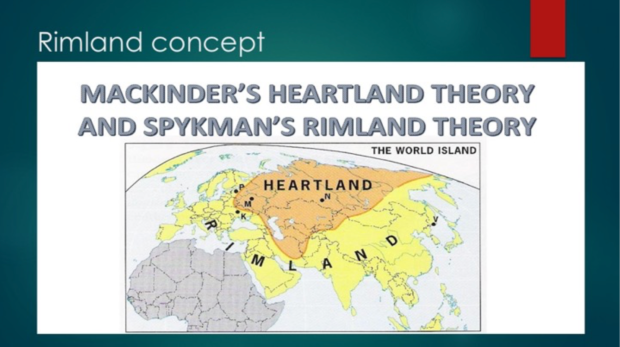
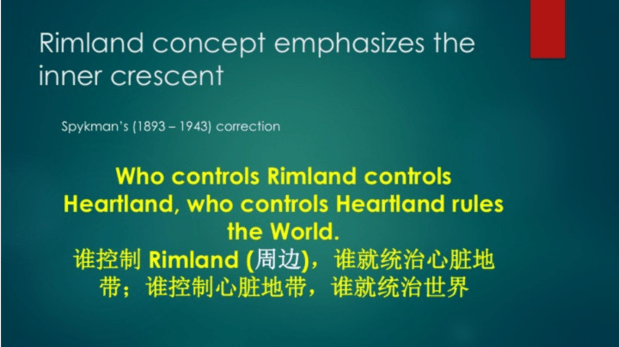

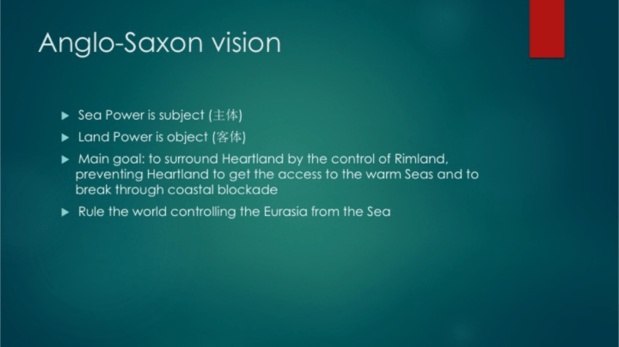 Very symbolically, Mackinder’s last article was published in an American journal, Foreign Affairs, whose editor’s organization, the Council on Foreign Relations, was created by the American elite just after the First World War in order to promote the Wilsonian vision of the United States as a global power operating in defense of capitalism, democracy, and so on. That was a theoretical, intellectual shift of the center of decision-making and the subject. This was a kind of transition of Sea Power. After that, Great Britain became the “old power”, the “senior”, “old man” tending his garden who offers some advice, but is not the real subject.
Very symbolically, Mackinder’s last article was published in an American journal, Foreign Affairs, whose editor’s organization, the Council on Foreign Relations, was created by the American elite just after the First World War in order to promote the Wilsonian vision of the United States as a global power operating in defense of capitalism, democracy, and so on. That was a theoretical, intellectual shift of the center of decision-making and the subject. This was a kind of transition of Sea Power. After that, Great Britain became the “old power”, the “senior”, “old man” tending his garden who offers some advice, but is not the real subject.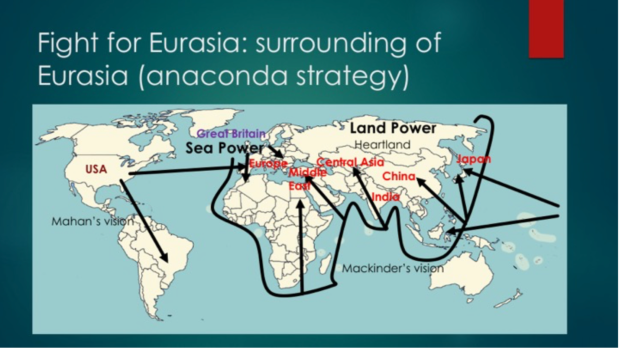

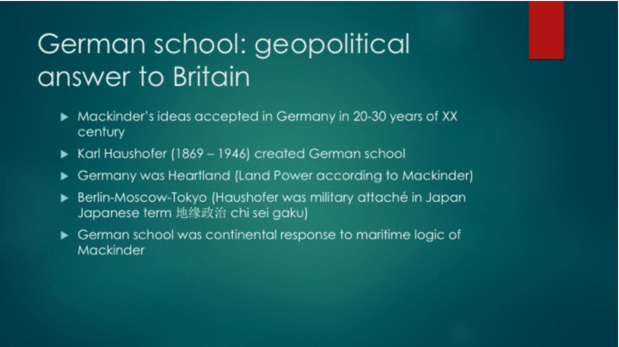
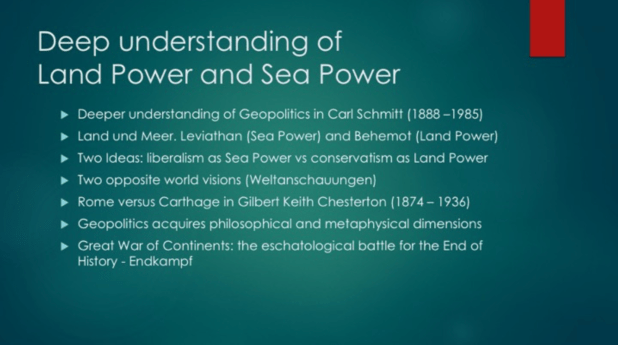
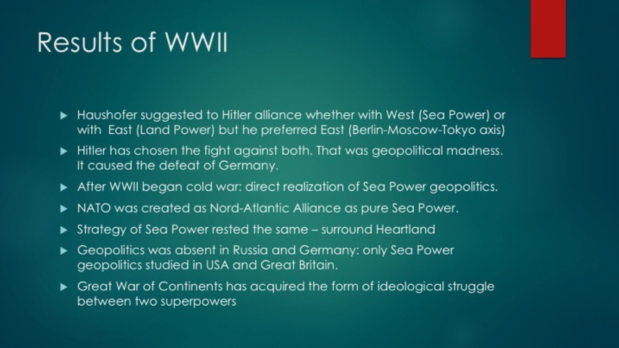 The result of the Second World War was that Hitler totally neglected Karl Haushofer’s advice. There was no more Germany, no more Hitler, no more National Socialism, because of the suicidal war that cost humanity many millions of victims. Just after the Second World War, the Cold War started, where there was again a pure illustration of the classic map of geopolitics. There was the Soviet camp, of which China was a part, the socialist camp, against the capitalist camp. There was a moment when the Soviet camp and communist, anti-capitalist countries acquired the geopolitical dimension of Behemoth. Communism was Behemothic in some ways. It was Land Power. That’s why communism won not in the industrial, liberal countries which had a big amount of proletarians, but in peasant, agrarian countries like Russia or China – because they were Land Powers. Communism won in Land Power, in the context of anti-liberal, anti-Western, anti-Sea Power. That is the geopolitical explanation of the Cold War.
The result of the Second World War was that Hitler totally neglected Karl Haushofer’s advice. There was no more Germany, no more Hitler, no more National Socialism, because of the suicidal war that cost humanity many millions of victims. Just after the Second World War, the Cold War started, where there was again a pure illustration of the classic map of geopolitics. There was the Soviet camp, of which China was a part, the socialist camp, against the capitalist camp. There was a moment when the Soviet camp and communist, anti-capitalist countries acquired the geopolitical dimension of Behemoth. Communism was Behemothic in some ways. It was Land Power. That’s why communism won not in the industrial, liberal countries which had a big amount of proletarians, but in peasant, agrarian countries like Russia or China – because they were Land Powers. Communism won in Land Power, in the context of anti-liberal, anti-Western, anti-Sea Power. That is the geopolitical explanation of the Cold War.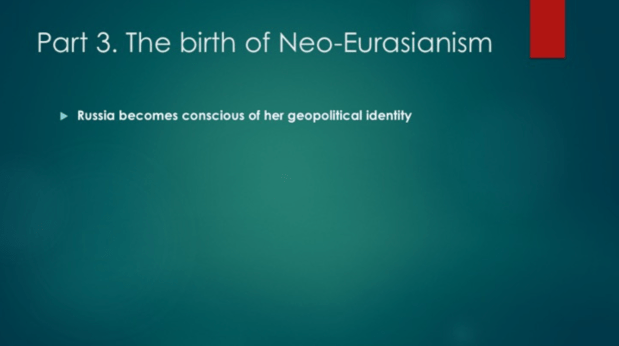
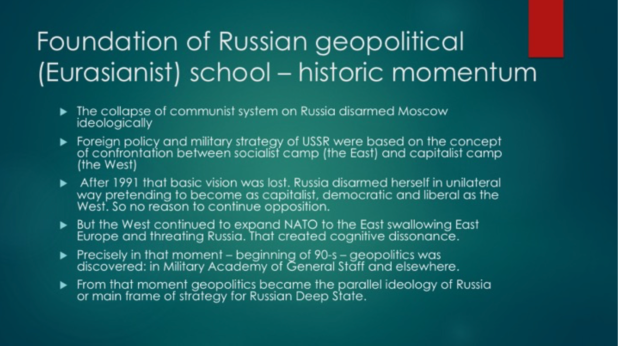
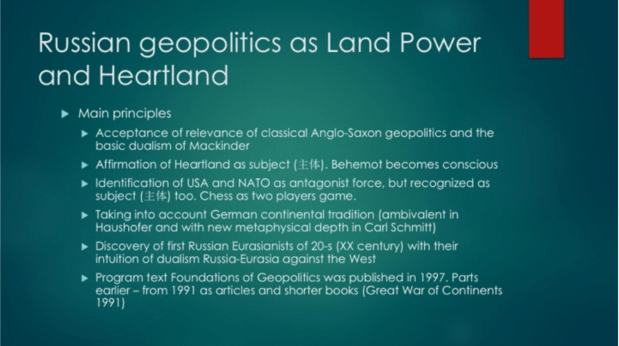
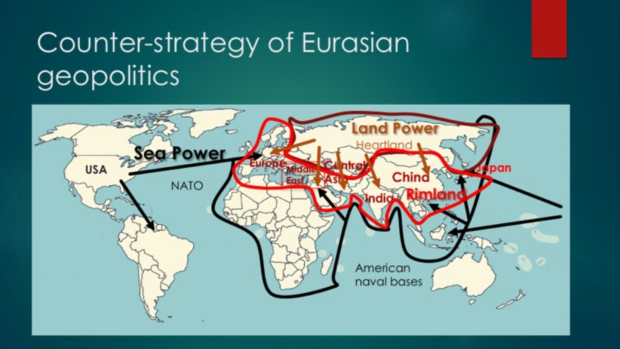

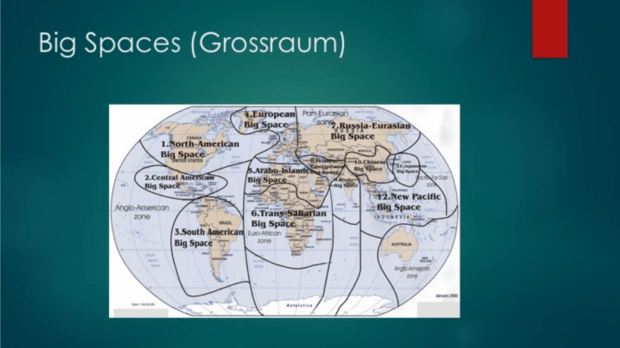
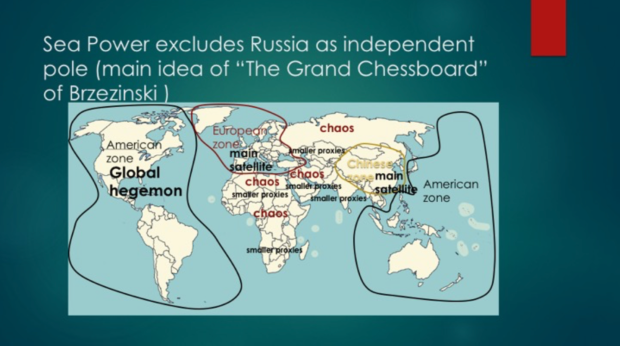

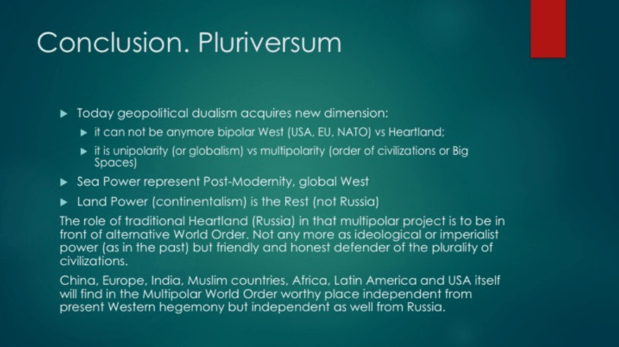



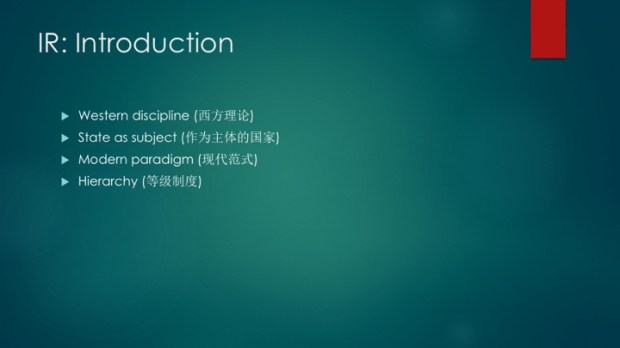
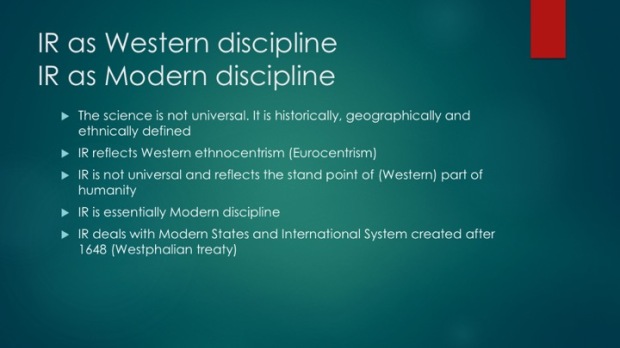
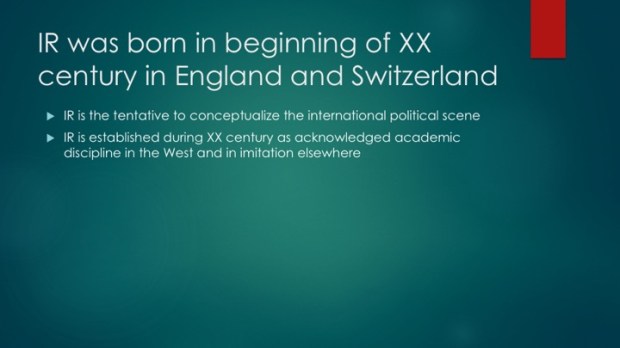
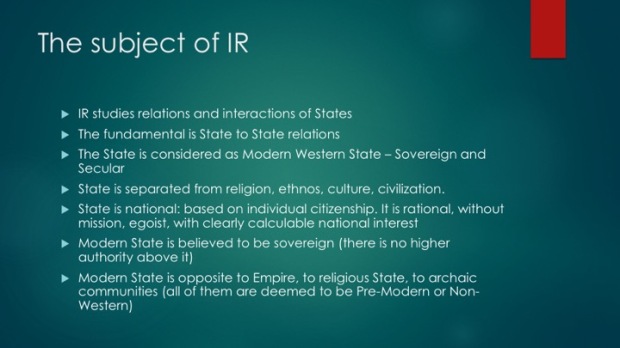




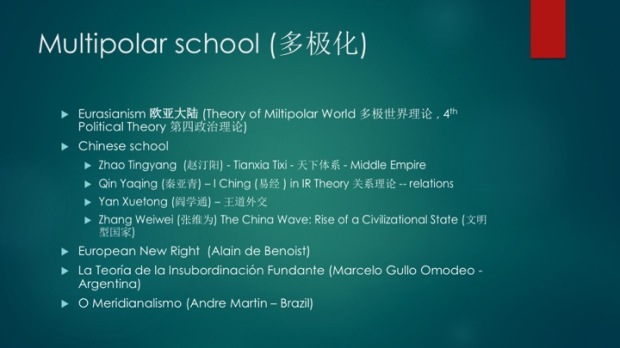
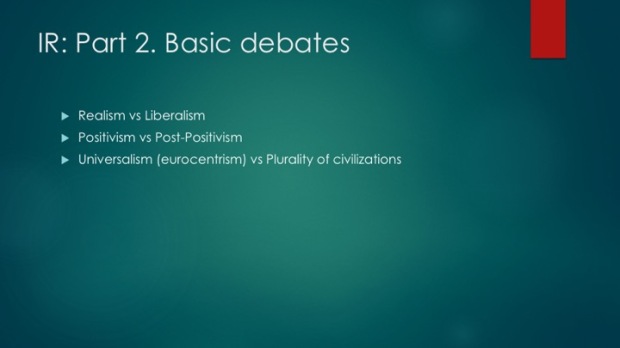
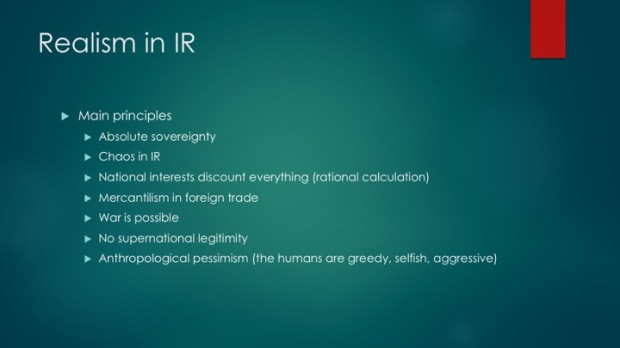

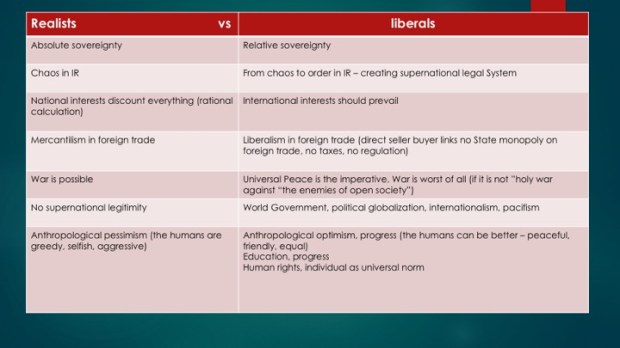
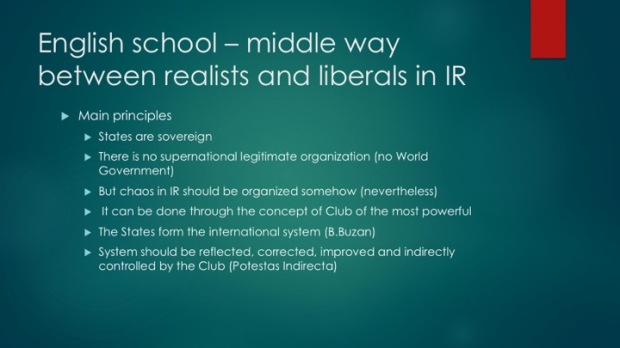

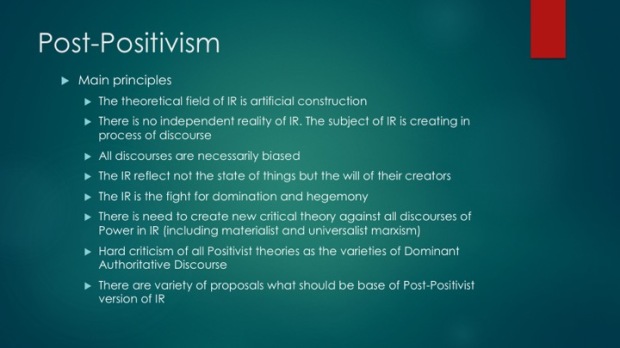 But the post-positivist schools are much more interesting in my opinion. There is the normativist theory that affirms that if we create a norm, then it does not reflect reality, but creates the reality, and everybody will follow the norm. If you try to punish people who violate some rule on the street, little by little this norm, which does not reflect anything, creates people who very carefully behave “correctly” because of these norms. By changing norms, we change reality – that is the modest version of post-positivism.
But the post-positivist schools are much more interesting in my opinion. There is the normativist theory that affirms that if we create a norm, then it does not reflect reality, but creates the reality, and everybody will follow the norm. If you try to punish people who violate some rule on the street, little by little this norm, which does not reflect anything, creates people who very carefully behave “correctly” because of these norms. By changing norms, we change reality – that is the modest version of post-positivism.